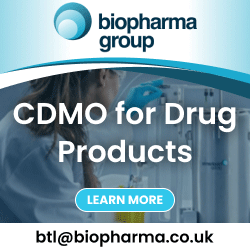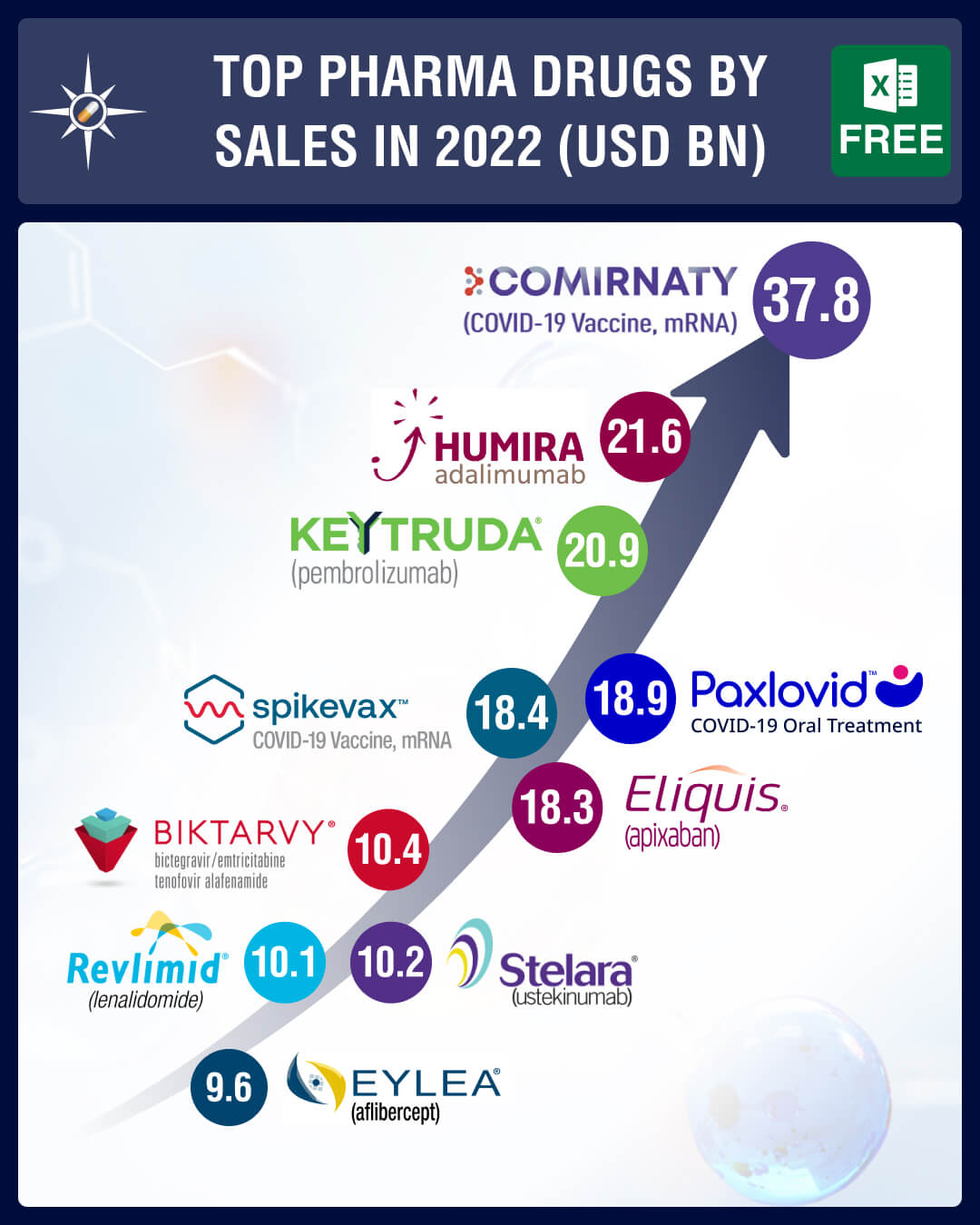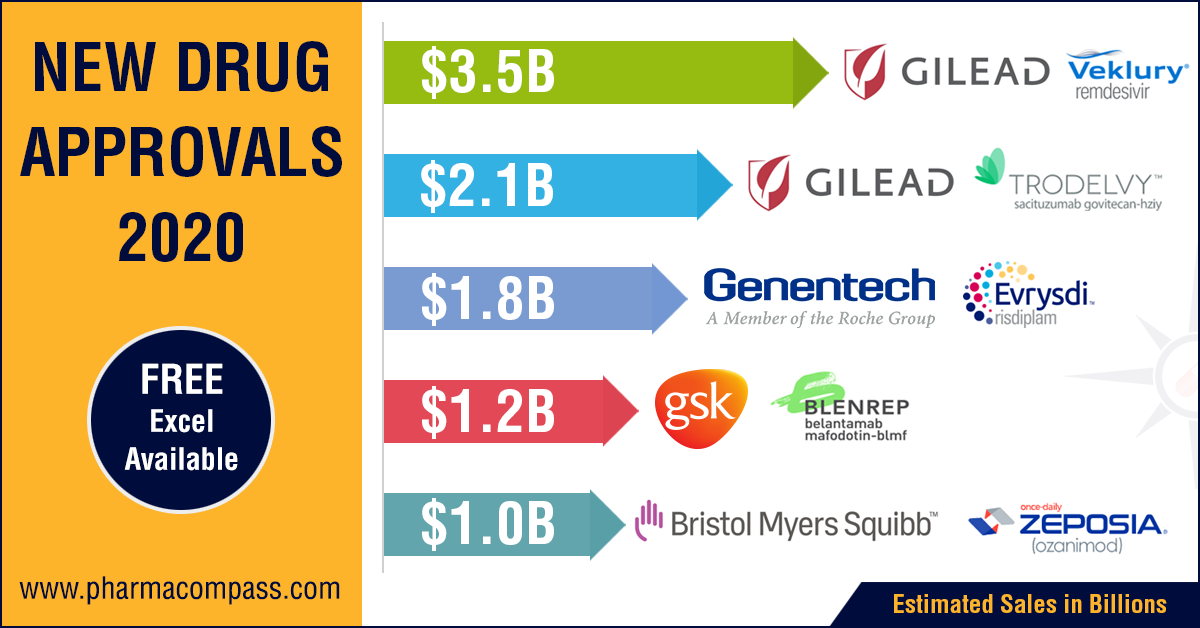In 2022, the pandemic continued to bring in a windfall for
pharmaceutical companies manufacturing Covid-19 products, with Pfizer’s total annual sales reaching
a record high by surpassing US$ 100 billion for the first time.AbbVie, despite not having any Covid products
in its portfolio, maintained its second position due to the sales of its blockbuster drug Humira and other medicines. Johnson & Johnson held
onto the third spot, while Merck experienced the most significant
change, climbing to the fourth position from seventh place in the previous
year. AstraZeneca also moved up a spot to the
eighth position. On the other hand, Novartis (fifth), Roche (sixth), BMS (seventh) and Sanofi (ninth) slipped in the rankings,
while GSK (tenth) retained its position.
There were no new entries in the top 10 in terms of pharmaceutical sales.View Our Interactive Dashboard on Top Drugs by Sales in 2022 (Free Excel Available)Pfizer retains top position
as Comirnaty, Paxlovid, together generate over US$ 56 billion In 2022, Pfizer’s Covid-19 products — vaccine Comirnaty and antiviral pill Paxlovid — generated combined sales of US$ 56.7 billion. With a haul of US$ 37.8 billion, Comirnaty comfortably
maintained its position as the top-selling drug for a second year in a row.
Paxlovid brought in US$ 18.9 billion in its first full year on the market, grabbing the number four spot.Moderna’s messenger RNA
Covid vaccine Spikevax generated US$ 18.4 billion in revenues, emerging as the
fifth largest drug by sales in 2022.View Our Interactive Dashboard on Top Drugs by Sales in 2022 (Free Excel Available) AbbVie’s Humira, J&J’s Stelara post impressive growth; BMS face revenue declineAbbVie’s cash cow Humira, the bestselling non-Covid
product in biopharma history, achieved sales of US$ 21.24 billion (partner Eisai reported another US$ 370 million) in 2022. While Humira brought in approximately 37 percent of the company’s total net revenues of US$ 58 billion in 2022, strong revenues from blood cancer drug Imbruvica, psoriasis treatment Skyrizi and rheumatoid arthritis med Rinvoq also contributed to AbbVie’s strong performance.J&J generated US$ 52.56 billion in 2022
revenues. Its pharmaceutical segment experienced an operational growth of 6.7 percent, driven by impressive
performance of key drugs such as Stelara for inflammatory diseases
and Darzalex for multiple myeloma.
Stelara, which generated US$ 10.2 billion in overall sales last year (a
growth of 6.9 percent), is expected to face
generic competition in the US as its
exclusivity is ending in 2023.BMS’ sales remained relatively
unchanged even though its blockbuster multiple myeloma drug, Revlimid, experienced a 22 percent
revenue decline due to generic competition. While Revlimid still generated
sales of US$ 9.98 billion (partner BeiGene reported another US$ 80 million) in 2022, two other drugs, anticoagulant Eliquis and cancer drug Opdivo performed well. Eliquis
generated US$ 11.8 billion in sales (partner Pfizer reported another US$ 6.5
billion), a 9.2 percent increase over 2021, while Opdivo achieved US$ 8.25 billion in sales (partner Ono Pharmaceuticals reported another US$ 1.05 billion). The drugmaker also introduced new products like Opdualag, Abecma and Reblozyl, which bolstered
its overall sales.View Our Interactive Dashboard on Top Drugs by Sales in 2022 (Free Excel Available)Merck expands use of blockbuster Keytruda; oncology drugs boost Astra’s revenueMerck’s blockbuster cancer drug Keytruda had a remarkable year,
achieving a significant year-on-year growth of 22 percent and generating US$ 20.9 billion in 2022 sales. This success propelled Keytruda to the third position among the top-selling drugs. Keytruda’s continuous expansion into new indications and treatment lines has solidified its position as a leading PD1 inhibitor, and is expected to maintain its momentum in 2023. Additionally, Merck’s Covid-19 pill Lagevrio recorded impressive sales of US$ 5.7 billion in 2022. Overall, at US$ 52 billion, the drugmaker posted spectacular
growth in sales of 22 percent.AstraZeneca also experienced an
impressive growth of 18 percent in 2022 to reach US$ 43 billion in revenue. The
growth was primarily driven by the success of its cancer treatments, with
blockbuster drugs like Tagrisso, Farxiga, Imfinzi, Lynparza playing a vital role. These drugs accounted for 35 percent of AstraZeneca’s overall revenue.View Our Interactive Dashboard on Top Drugs by Sales in 2022 (Free Excel Available)Newer
meds bolster Roche’s growth; Sanofi thrives with DupixentIn 2022, Roche experienced a sales growth of 2 percent at Constant Exchange Rate (CER) to reach CHF 45.55 billion (US$
49.8 billion). The company’s strong pharmaceutical sales were fueled by increasing demand for newer medicines, including Ocrevus (for multiple sclerosis), Hemlibra (for hemophilia A), Vabysmo
(for eye conditions), Evrysdi (for spinal muscular
atrophy) and cancer drug Tecentriq. In 2022, Sanofi recorded global sales of €43 billion (US$ 47.1 billion), representing a 7 percent growth at CER. The French drugmaker’s strong performance was driven by major drugs, particularly Dupixent and its vaccine franchise.
Dupixent brought in impressive sales of €8.3 billion (US$ 9.1 billion), marking a significant 57 percent increase over the previous year. Originally approved by the FDA in 2017 for atopic dermatitis,
Dupixent has expanded its applications to include moderate to severe asthma and
eosinophilic esophagitis, contributing to its continued growth. Sanofi expects
Dupixent to reach €10 billion (US$ 10.7 billion) in sales
in the current year.In July 2022, GlaxoSmithKline changed its name to GSK and demerged its consumer
healthcare business to form Haleon, thereby becoming a fully
focused biopharmaceutical company. The British drugmaker reported a modest 8 percent growth in revenue — at £29.32 billion (US$ 36.15 billion).View Our Interactive Dashboard on Top Drugs by Sales in 2022 (Free Excel Available)Our viewAs the pandemic wanes, 2023 could be a year of transition for many
drugmakers. Companies such as Pfizer, Moderna and AbbVie are implementing
significant changes to their business strategies. Pfizer foresees a substantial
decline in revenue, projecting a sharp drop of 33 percent with the reduced demand for
its Covid-19 products. AbbVie, on the other hand, anticipates a decline in
sales of its cash cow Humira due to increasing competition from biosimilars.
These drugmakers are turning to innovative therapies, new indications,
cost-cutting measures, acquisitions and partnerships to restrict the
anticipated drop in revenues and ensure sustained growth.Barring these drugmakers, several other big players shared
positive growth in the first quarter of 2023. While analysts predict Keytruda
and Dupixent to continue their strong growth, there is optimism surrounding diabetes and obesity drugs,
with Novo Nordisk’s Wegovy experiencing unprecedented
demand. Eli Lilly is also anticipating the US
approval of Mounjaro for obesity later this year.
All in all, we anticipate more changes in our list of top companies and drugs
for 2023!
Impressions: 5197
The year
2020 was an eventful year for the pharmaceutical industry, with several
companies across the world working at a feverish pace to find a treatment or a
vaccine for the raging Covid-19, which has so far taken over 1.79 million lives
worldwide.
With
countries imposing lockdowns and regulators putting on-site inspections on
hold, we were expecting far lower new drug approvals in mid-2020. But our mid-2020 recap published in July, which
looked at new drug approvals by the US Food and Drug Administration (FDA) and European Medical Agency (EMA),
found that the FDA had approved 33 new drugs by the end of June. This put the
approvals within the ballpark of the past two years.
This week, we bring you a roundup of 2020, a tumultuous year when 58 drugs (53 approvals by the Center for Drug Evaluation and Research and 5 by the Center for Biologics Evaluation and Research) bagged FDA’s new drug approvals. While this number is lower than the number of drugs approved in 2018 (62), it is higher than the number for 2019 (54). Out of this, while 23 approvals were in the field of oncology, 9 were for infectious diseases and infections, 8 for genetic diseases, 7 for neurology, 3 for immunology and 2 for gastroenterology.
View New Drug Approvals in 2020 with Estimated Sales (Free Excel Available)
A year marked by EUA
With the pandemic raging across the world, emergency use authorizations (EUAs) dominated news headlines in 2020 — the FDA issued 10 EUAs, with the most
prominent being those issued to Pfizer-BioNTech and Moderna for their Covid-19 vaccines.
EMA was busy as well since they issued 75 positive opinions
with Novartis leading
the pack with 8, followed by Pfizer and Sanofi which received 4 each.
The EUAs came with their own set of controversies. In March,
the FDA had issued an EUA “for oral formulations of chloroquine phosphate and hydroxychloroquine sulfate
for the treatment of” Covid-19. However, by June, FDA had revoked the EUA,
as the agency determined that chloroquine and
hydroxychloroquine were not likely to be effective in treating Covid-19 for the
authorized uses in the EUA.
Amongst treatments for Covid-19, in May the FDA
authorized the emergency use of Gilead’s antiviral
drug remdesivir. In our mid-2020 recap, Gilead’s remdesivir was on top of
our list of top-selling drugs after it received an EUA from the FDA.
In October, remdesivir became the first drug to
be approved by the FDA for treatment of Covid-19 patients requiring
hospitalization. While analysts predicted US$ 3.5 billion in revenue in early
October, the future of this drug as a treatment for Covid-19 in hospitalized
patients remains uncertain, especially in wake of results from the World Health
Organization (WHO)-led Solidarity Trial that said Gilead’s remdesivir
had little or no effect on the 28-day mortality or length of hospital
stays for Covid-19 patients. The FDA approved remdesivir for
hospitalized patients a week after the WHO results.
View New Drug Approvals in 2020 with Estimated Sales (Free Excel Available)
Gilead US$ 21 billion Immunomedics acquisition
Immunomedics' antibody-drug conjugate (ADC) — Trodelvy (sacituzumab govitecan-hziy) — was approved by the FDA in April this year for the treatment of adult patients with metastatic triple-negative breast cancer who have received at least two prior therapies for the disease. Such tumor types account for 15 to 20 percent of breast cancers. Trodelvy follows remdesivir in our list of FDA approved drugs in 2020 with the highest sales potential. The current forecast for Trodelvy sales is US$ 2.151 billion by 2026.
In
September, Gilead made a big move and acquired biotech company
Immunomedics Inc for US$ 21 billion. The
transaction, which was completed in October, will strengthen Gilead’s cancer portfolio and add another potential blockbuster to it.
Immunomedics
plans to submit a supplemental Biologics License Application (BLA) to support
full approval of Trodelvy in the US over the next quarter. According to a statement, Immunomedics
is also on track to file for regulatory approval of the drug in Europe in the
first half of 2021. Moreover, ongoing studies are also evaluating the potential
of Trodelvy as a treatment for non-small cell lung cancer and other types of
solid tumors.
View New Drug Approvals in 2020 with Estimated Sales (Free Excel Available)
Roche-PTC Therapeutics’ risdiplam bags approval
Following
Troveldy in sales potential for drugs approved by the FDA is Roche and PTC Therapeutics’ drug Evrysdi (risdiplam), the first oral medicine approved for the
rare genetic disease, spinal muscular atrophy, which until four years ago had
no available treatments.
The approval of Evrysdi presents patients and their families with a unique choice between a one-time gene therapy, an RNA-based drug infused three times a year at the doctor’s office and a daily medicine taken at home.
Roche priced the drug by patient weight, with a maximum cost of US$ 340,000 per year — substantially lesser than the competing (and approved) therapies from Biogen and Novartis.
View New Drug Approvals in 2020 with Estimated Sales (Free Excel Available)
Vertex’s Kaftrio bags EMA approval
Earlier
this year, PharmaCompass had published its compilation of sales
forecasts for the new drugs approved by the FDA in 2019. The list was led by Vertex’s cystic
fibrosis treatment — Trikafta — which was expected to have sales of US$ 3.935 billion by 2024.
Trikafta
is a combination of ivacaftor, tezacaftor and elexacaftor and its
stellar clinical data made the FDA approve the drug within three months of
Vertex’s application
filing and five months before FDA’s action date.
In
June 2020, EMA’s CHMP adopted a positive opinion, recommending the granting of a marketing authorization for
Vertex’s
combination, which will be marketed as Kaftrio.
View New Drug Approvals in 2020 with Estimated Sales (Free Excel Available)
A year
of multiple setbacks
Not everything went smoothly in 2020. In fact, the year saw several setbacks — almost 44 drugs were not granted approval by the FDA. Bristol Myers Squibb was one such company that
received setbacks. As part of Bristol’s US$ 74 billion acquisition of Celgene, the New
York-headquartered drug company offered Celgene shareholders Contingent Value Rights or
CVRs. But to realize the US$ 9-a piece payment, approvals for three
ex-Celgene drugs must meet their pre-specified deadlines.
While in March, the FDA approved Bristol’s ozanimod, a sphingosine-1-phosphate receptor agonist for the treatment of relapsing multiple sclerosis, well ahead of the December 31, 2020 deadline, in May, Bristol Myers Squibb and bluebird bio, Inc announced
that they have received a Refusal to File letter from FDA regarding the Biologics License Application (BLA) for their CAR-T therapy — idecabtagene vicleucel
(ide-cel) — for patients with heavily pre-treated relapsed and refractory multiple myeloma, which was submitted in March 2020. Upon preliminary review, the FDA
determined that the Chemistry, Manufacturing and Control (CMC) module of the
BLA requires further details to complete the review.
This was
followed by Bristol Myers announcing that the FDA has extended the action date
by three months for the BLA for lisocabtagene maraleucel (liso-cel), a
CD19-directed CAR-T therapy for the treatment of adults with relapsed or
refractory (R/R) large B-cell lymphoma after at least two prior therapies. The
FDA had then set the new Prescription Drug User Fee Act (PDUFA) action date as
November 16, 2020. However, on that day, FDA informed the company that its
review of the BLA for liso-cel will not be completed by November 16.
The FDA
approval of liso-cel by December 31, 2020 is one of the required remaining
milestones of the CVRs issued upon the close of the Celgene acquisition in the
fourth quarter of 2019. The other is FDA approval of ide-cel by March 31, 2021.
FDA declines approval to Novartis’ inclisiran: Recently, there was news that
the FDA declined to approve Swiss drugmaker Novartis AG’s lipid-lowering therapy, inclisiran (branded as Leqvio). The drug came to Novartis' fold through the
US$ 9.7 billion acquisition of The Medicines Company last year. The drug has been cleared by the European Commission.
In a statement, Novartis said the
FDA has not raised any concerns
related to the efficacy or safety of inclisiran. The complete
response letter (CRL) is due to unresolved facility inspection-related
conditions. No onsite inspection was conducted by the FDA, the company said.
View New Drug Approvals in 2020 with Estimated Sales (Free Excel Available)
Our
view
Like the
drug companies, regulators across the world also worked at a frenetic pace in
order to accelerate EUAs and drug approvals, especially for treatments and
vaccines for Covid-19.
Apart from
Covid-19, the year saw wider adoption and
approvals for cell and gene therapies along with approvals of several innovative medicines like relugolix (the first
oral gonadotropin-releasing hormone receptor antagonist for the treatment of
adult patients with advanced prostate cancer), berotralstat
the first oral once daily plasma kallikrein inhibitor to prevent attacks of
hereditary angioedema in adults and pediatric patients 12 years and older,
lumasiran (an HAO1-directed small interfering
ribonucleic acid indicated for the treatment of primary hyperoxaluria type 1 to lower urinary oxalate levels in pediatric and adult
patients) and osilodrostat for the treatment of adults with Cushing’s disease).
Moreover, there were several interesting ‘non-Covid’ medical breakthroughs that took place during 2020. One such breakthrough is a single pill that combines four medications meant to
lower blood pressure and cholesterol and aspirin that was found to cut the risk
of heart disease.
While the agility shown by pharma companies and regulators was
undoubtedly quite impressive, with many countries granting EUA to vaccines for
Covid-19, the ongoing pandemic did put mankind in a bind for several months.
And if the words of the WHO director general Tedros
Adhanom Ghebreyesus are to be believed, the
coronavirus crisis will not be the last pandemic and attempts to improve human health are “doomed” without tackling climate change and animal welfare.
If that really proves to be the case, the pharma industry has a lot to learn from this pandemic, and science has a lot to demonstrate if mankind is to emerge unscathed from such adversities.
View New Drug Approvals in 2020 with Estimated Sales (Free Excel Available)
Impressions: 6883














